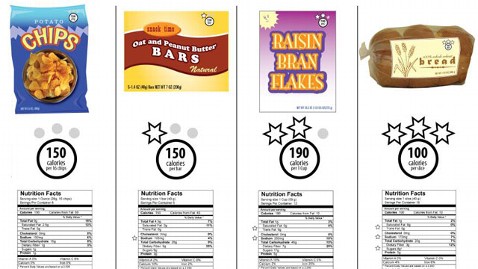Will New Food Labels Mean Better Choices?

This illustration provided by the Institute of Medicine shows one of three proposed food labels intended to help consumers make healthful choices. (Institute of Medicine)
Dr. David Katz reports:
To help hurried shoppers make healthier food choices, the Institute of Medicine has called for a new food labeling system that would require nutritional information to appear on the front of the package instead of only on the back.
Like the Energy Star tag that helps shoppers compare appliances, the new front label would, theoretically, make it easier for customers to compare the number of calories, and the fat, sodium and sugar content in cans of soup, boxes of cereal and tubs of yogurt without having to turn the product over and squint to read the small print on the back.
The IOM got to work on a new labeling system following what can only be called the Smart Choices debacle. Smart Choices was a front-of-package nutrition label developed by the food industry that led to the infamous conclusion that Froot Loops was a smart choice for breakfast.
That, among other dubious findings, invited the wrath of the federal government, and Smart Choices was retired.
The IOM then stepped in to review food labeling in a two-phase effort, culminating in its latest recommendation.
And its latest recommendation does have its advantages: For one, it could unify the food industry’s different product icons and symbols into a single system. It could also highlight potentially harmful nutrients very visibly on the front of the package and put the reins on deceptive marketing to some degree.
Despite its advantages, the IOM’s new labeling system is not without its weakensses. The system was designed with no market research — it didn’t even use consumer focus groups. Relying on previously published literature, the IOM failed to answer what food guidance works best for consumers or what kind of labeling could change purchasing behavior and lead to better health outcomes.
Also, if calories, saturated fat, trans fat, added sugar and sodium are to be called out, then diet soda, which contains none of these elements, would likely pass through the IOM’s filter as a perfect food, while walnuts, avocados or nut butters, which are highly nutritious but energy dense, would appear as bad choices.
It’s hard to imagine that’s what the IOM intended.
Dr. Katz is the director of the Yale University Prevention Research Center.